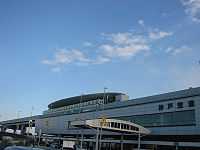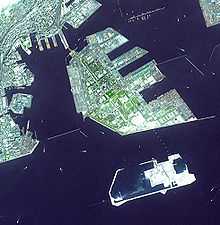Kobe Airport
| Kobe Airport 神戸空港 Kōbe Kūkō | |||
|---|---|---|---|
 | |||
| IATA: UKB – ICAO: RJBE | |||
| Summary | |||
| Airport type | Public | ||
| Owner | City of Kobe | ||
| Operator | Osaka Aviation Bureau (airfield), Kobe Airport Terminal Co., Ltd. (terminal) | ||
| Serves | Kobe, Japan | ||
| Location | Chuo-ku, Kobe | ||
| Hub for | Skymark Airlines | ||
| Elevation AMSL | 22 ft / 7 m | ||
| Coordinates | 34°37′58″N 135°13′26″E / 34.63278°N 135.22389°ECoordinates: 34°37′58″N 135°13′26″E / 34.63278°N 135.22389°E | ||
| Website | |||
| Map | |||
 RJBE | |||
| Runways | |||
| Direction | Length | Surface | |
| m | ft | ||
| 09/27 | 2,500 | 8,202 | Asphalt concrete |
| Source: Japanese AIP at AIS Japan[1] | |||
Kobe Airport (神戸空港 Kōbe Kūkō) (IATA: UKB, ICAO: RJBE) is an airport on an artificial island just off the coast of Kobe, 8 km (5.0 mi) south of Sannomiya Station[1] Japan. It primarily handles domestic flights, but can also accommodate international charter flights. In the first year of operation (2006) the airport handled 2,697,000 passengers with an average load factor of 61.1%. In FY 2010 it handled 2,215,000 passengers with an average load factor of 69.2%.[2]
History
The city government of Kobe first proposed an airport adjacent to Port Island in 1971. At the time, government planners were seeking alternatives to the heavily congested Osaka International Airport: the original Kobe Airport plan called for six runways more than 3,000 m (9,843 ft) in length on a 1,100 ha (2,700 acres) facility. The mayor of Kobe, Tatsuo Miyazaki, declared his opposition to building such a large airport so close to the city, and was re-elected shortly afterward in 1973, defeating a competitor who supported the airport.[3]
Kobe businesses were still interested in the plan, however, and pressed the city government to propose a smaller facility with one 3,000 m (9,843 ft) runway. This plan was submitted to the Transport Ministry in 1982 as a competitor for the Kansai International Airport plan which was then being supported by the Osaka and Wakayama prefectural governments. After the national government voiced its displeasure with the Kobe proposal, Kobe officially switched its support to the Kansai Airport proposal in 1984, but in 1985 decided to independently fund the construction of another airport.[3]

The construction of the airport was stalled for lack of funding until 1995, when it won national government support as a means for recovering the Kobe economy in the wake of the great Hanshin earthquake. Despite ongoing controversy, locals continued to support the plan: in the 1997 mayoral election, the pro-airport coalition won a narrow victory over the anti-airport coalition. Construction began in September 1999 but political controversy continued: 87,000 signatures were collected in a petition to recall the mayor in 2000, and a citizen lawsuit to cancel the project was dismissed in 2004.
The airport finally opened on February 16, 2006, with Japan Airlines operating the first flight and All Nippon Airways operating the first scheduled flight. Both ANA and JAL announced plans to replace portions of their widebody fleet with a larger number of mid-size aircraft, in part because of a need to fill the excess number of flight slots created by Kobe Airport's construction.[4] The airport handled its first international private aircraft flight in September 2006.[5]
As part of its bankruptcy restructuring, JAL terminated all services out of Kobe and closed its office on June 1, 2010, in response to which Skymark Airlines announced a major expansion at the airport.[6] ANA also cut back services following the airport's opening. Skymark is currently the dominant carrier at Kobe carrying approximately two-thirds of its passengers.[7]
In 2013, Kobe mayor Tatsuo Yada endorsed a proposal to consolidate the management of the three Kansai region airports by adding Kobe Airport to the planned sale in 2014 of operating concessions at Itami and Kansai, although the Nihon Keizai Shimbun reported this to be unlikely given the advanced state of negotiations surrounding the concessions.[8]
Kobe is already the most indebted municipality in Japan with debts of over ¥3 trillion, and this project's cost (estimated at over ¥1 trillion, or US $8.7 billion) has made it very controversial. Supporters argue that the third airport can mean increased competition and lower airfares. People in the surrounding regions (Shikoku, Awaji Island etc.) can now have a closer airport while access to Kansai may be limited. Since the ferry from Tokushima to Kansai Airport was discontinued, travellers have had to rely on alternate means of transportation including a bus to Kansai Airport, which takes an hour longer, or to use the local Tokushima airport, which is limited in schedules.
Airlines and destinations

Kobe has a single passenger terminal with four gates capable of accommodating widebody aircraft.
| Airlines | Destinations |
|---|---|
| Air Do | Sapporo-Chitose |
| All Nippon Airways | Sapporo-Chitose, Tokyo-Haneda |
| Solaseed Air | Naha |
| Skymark Airlines | Ibaraki, Ishigaki, Kagoshima, Nagasaki, Naha, Sapporo-Chitose, Tokyo-Haneda, Yonago |
Some international charter flights also use Kobe Airport. Although the airport's runway is not long enough to handle long-range flights to Europe and the Americas, it occasionally handles charters to China and other nearby countries.
The Transport Ministry has capped scheduled domestic operations at 30 daily flights, and has banned international flights with the exception of private aircraft and "own use" charters, in order to prevent overcrowding in the area's airspace and to protect the growth of Kansai Airport.[3] The flight caps have been a point of controversy with Kobe Airport supporters, who point out that the cap was calculated based on Kansai Airport operating twice as many frequencies as are currently offered: given the current traffic levels at Kansai, Kobe should be able to handle six or seven flights per hour.
Ground transportation
On February 2, 2006, Kobe Airport Station (神戸空港駅) was connected to Sannomiya Station in central Kobe by an extension of the existing Port Liner automated guideway transit system, using 2000 series trains as well as some older 8000 series trains (older trains being gradually replaced by newer 2000 ones). Travel time to Sannomiya is 16 minutes. From Sannomiya, it is 21 minutes to Ōsaka Station and 49 minutes to Kyoto Station by JR special rapid express.
Kobe Airport is connected to Kansai Airport by the Kobe-Kanku Bay Shuttle (神戸-関空ベイ・シャトル), a high speed ferry which completes the airport-to-airport journey in 29 minutes for ¥1,500.

Related matters
References
- ↑ 1.0 1.1 AIS Japan
- ↑ http://www.city.kobe.lg.jp/life/access/airport/riyouzisseki.html
- ↑ 3.0 3.1 3.2 "関西3空港のあり方について(提言)". 財団法人 兵庫地域政策研究機構. March 2010. Retrieved 12 December 2013.
- ↑ Shimizu, K. "JAL, ANA eye smaller jets to meet changing needs". in Japan Times, Oct 2004., retrieved February 15, 2007
- ↑ http://www.city.kobe.lg.jp/life/access/airport/index_04.html
- ↑ "兵庫県と神戸市・神商、神戸空港24時間化など要望 国交省に". 日本経済新聞. 1 June 2010. Retrieved 12 December 2013.
- ↑ http://www.city.kobe.lg.jp/life/access/airport/img/HP23.5.pdf
- ↑ "神戸市長、3空港一体に意欲". 日本経済新聞. 5 October 2013. Retrieved 12 December 2013.
External links
| Wikimedia Commons has media related to Kobe Airport. |
- (English) Japan Guide: Kobe Airport
- (English) Kobe Airport Terminal
- (Japanese) Kobe Airport Terminal
- (Japanese) Kobe Airport Marine Air
- Kobe Airport Guide from Japan Airlines
- Current weather for RJBE at NOAA/NWS
- Accident history for UKB at Aviation Safety Network
| ||||||||||||||||||||||||||
| |||||||||||||||||||||||